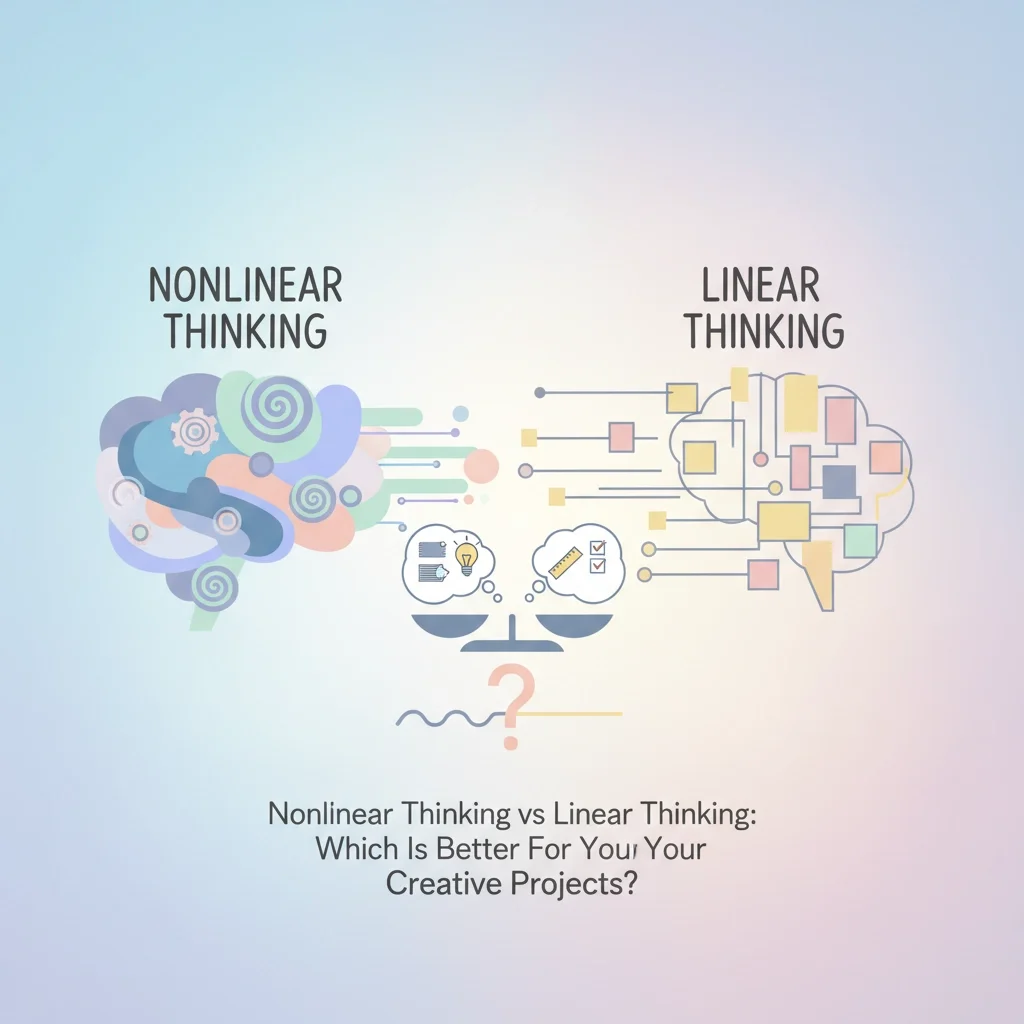Nonlinear Thinking vs Linear Thinking: Which Is Better For Your Creative Projects?
Your mind doesn't move in straight lines, does it?
Maybe you're the type who starts a creative project with seventeen different ideas swirling at once. Or perhaps you're someone who needs to map everything out, step by careful step, before you can even begin.
Here's what we want you to know: both ways of thinking are magic. Both have their place in your creative world.
The truth about creative projects? Nonlinear thinking typically holds the advantage when it comes to generating those breakthrough ideas that make your work sparkle. But the most sustainable creative practice weaves both thinking styles together, like golden threads in a tapestry you're still learning to see.
When Your Mind Moves Like Water
Nonlinear thinking is where your creative soul lives and breathes.
It's that beautiful, chaotic dance where your thoughts leap from concept to concept: making connections that don't make sense to anyone else, but feel like coming home to you. You might start thinking about a podcast episode and suddenly find yourself three layers deep in a completely different story, one that somehow contains the exact insight you needed.
This is your mind operating in multiple directions at once, with multiple starting points where logic can bloom in its own time. You welcome ambiguity like an old friend. You see patterns others miss. You connect dots that exist in different universes entirely.
And this is where innovation lives.
Your nonlinear mind thrives on:
Jumping between seemingly unrelated ideas
Making unexpected connections that feel like magic
Exploring concepts from different angles simultaneously
Welcoming uncertainty as creative fuel
Grasping abstract concepts that linear thinkers find challenging
If you've ever felt scattered or unfocused, we want you to hear this: your mind isn't broken. It's expansive.
When Structure Becomes Your Friend
Linear thinking moves like a gentle river: one thought flowing naturally into the next, following a clear path from beginning to end.
This is the part of you that can sit down with a plan and execute it beautifully. The part that remembers deadlines and follows through on commitments. The part that takes your wild, wonderful ideas and gives them structure so they can actually exist in the world.
Linear thinking offers gifts that your creative projects desperately need:
Clear step-by-step processes
Logical problem-solving approaches
The ability to complete projects from start to finish
Organizational systems that actually work
Structure that supports your wildest dreams
Without linear thinking, your beautiful ideas might remain forever floating, never quite landing in the hands of people who need to hear them.
The Dance Between Both
Here's where it gets interesting for your creative projects.
Nonlinear thinking generates the magic. It's what makes your work uniquely yours. It creates those "aha!" moments where you realize you've been approaching everything from the wrong angle, and suddenly a completely new path opens up.
Linear thinking brings the magic to life. It's what helps you actually finish the podcast episode, publish the blog post, or complete the art piece you've been dreaming about.
Think of it this way:
The most innovative creative work happens when both types of thinking dance together.
How to Honor Both in Your Creative Process
During Ideation: Let Your Mind Wander
This is nonlinear thinking's time to shine. Don't structure anything yet. Let your thoughts move like butterflies from flower to flower. Welcome the tangents. Follow the seemingly random connections. Trust that your mind knows what it's doing, even when it doesn't feel that way.
Give yourself permission to explore without destination. Some of your best ideas will come from the places you never planned to visit.
During Development: Blend Both Worlds
Once you have ideas that feel alive, start introducing gentle structure. But keep space for your nonlinear mind to surprise you. Maybe you're outlining a creative project, but you leave room for spontaneous insights to reshape everything.
This is where you learn to dance with both parts of yourself.
During Execution: Structure Serves Your Vision
When it's time to actually create and complete your project, linear thinking becomes your steady companion. You need systems, deadlines, and processes that help you follow through.
But here's the beautiful part: even in execution, your nonlinear mind can solve problems in ways that pure structure never could.
Your Creative Projects Need Both Minds
If you're someone whose mind moves in spirals and loops, know this: your way of thinking is not a limitation to overcome. It's a superpower to harness.
And if you're someone who naturally thinks in sequences and systems, your gift is equally precious. You have the ability to take scattered beauty and give it form.
Most of us have access to both types of thinking, even if one feels more natural. The invitation is to become curious about both, to honor both, and to use both in service of your creative vision.
Making Peace with Your Thinking Style
Maybe you've spent years feeling like your mind works differently from everyone else's. Maybe you've been told you're too scattered, or too rigid, or that you need to think more like someone else.
We're here to tell you that your thinking style is not a mistake.
Your nonlinear mind sees connections others miss. Your linear mind creates stability others crave. Both are needed. Both are welcome here.
The goal isn't to change how you think naturally: it's to expand your toolkit so you can create more freely and finish more consistently.
An Invitation to Begin
Your creative projects are waiting for the full spectrum of your mind.
They need your wild, expansive ideas and your ability to give those ideas structure. They need your spontaneous insights and your commitment to follow through. They need both your magic and your methodology.
Start where you are. Use what feels natural. Then gently, curiously, explore what feels less familiar.
Your creative work will be richer for it. And so will the people who get to experience what you create.
What creative project has been calling to you? What would it look like to approach it with both the expansiveness of nonlinear thinking and the clarity of linear structure?
We'd love to hear about the magic you're making. Your voice matters here.





